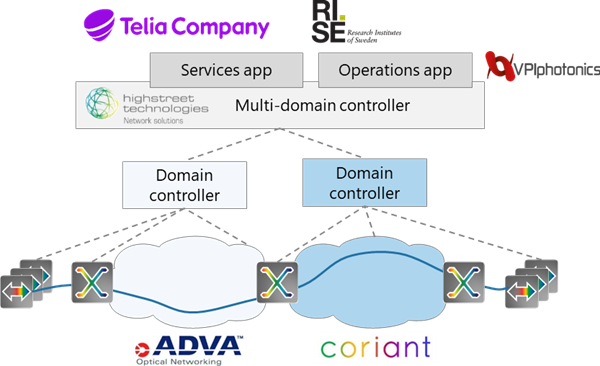Inflexible and monolithic transport network solutions are little use when it comes to meeting the agile connectivity requirements of the cloud, 5G and IoT. Networks must be able to respond immediately to changing bandwidth needs. Complex network planning and time-consuming, failure-prone manual provisioning processes are no longer an option. Networks need to support and eventually replace slow processes with automation and intelligent control.
The advantages of openness and multi-vendor networking are significant. In an increasingly competitive bandwidth services market, communication service providers (CSPs) can’t afford to wait for vendors to kick-off development projects for feature innovation. They urgently need the benefits of open networking to continuously innovate their network and service offerings and improve operational practices.
SDN is the technology of choice when it comes to making the leap from single-vendor network management to automated multi-domain control. It can be applied at all connectivity network layers, including IP/MPLS, Ethernet and down to the photonic network. What’s more, as well as combining different layers, SDN can unify different vendor domains with a common control instance, as highlighted in numerous demonstrations using SDN in digital packet networks. Now SDN architectures are starting to be applied with disaggregated optical networks, meeting the challenge of analog optical transmission.
An open, disaggregated photonic transport network enables a CSP to mix and match components and subsystems from various suppliers. Open line systems in combination with multi-vendor transponder technology is the preferred approach to disaggregated photonic systems. However, the implementation of SDN-enabled automated operation is most challenging with multi-vendor optical transmission systems, as various technical problems need to be resolved:
- SDN interface specifications have been developed by several open communities such as ONF and IETF. Existing interface protocols such as ONF T-API need to be augmented to handle analog optical transmission links.
- Any extension of protocols requires interoperability to be verified between vendor domains and multi-domain controllers, and between multi-domain controllers and north-bound entities such as operational support systems or customer portals.
- Reach planning in optical transparent systems across different vendor domains must build on a normalized set of analog parameters. Real-time path design in analog optical transmission systems needs accurate system data such as modulation technique and launch power, fiber characteristics, and optical amplifier noise behavior.
These challenges stretch across very different competence domains. There’s also a high risk of proprietary solutions if these issues are addressed by a single supplier. That’s why several very different companies have joined an open network automation ecosystem under the framework of the EU-funded SENDATE project. It began with suppliers of optical transmission systems, open-source controllers and network planning tools taking guidance from a major CSP’s operational requirements. With the support of research institutes, SDN technology was designed to control analog optical links across multiple vendor domains. Microservice-based reach planning showcased the potential for significant operational simplification empowered by an open SDN architecture.
The cooperation of such a range of stakeholders from different competence domains underlines the relevance of this use cases for streamlining the digital transformation of communication and IT networks. The multi-stakeholder field trial hosted by Telia Company R&D labs in Stockholm, Sweden, was supported with expertise from RISE, the Swedish research institute, building on network optimization and open SDN control solutions from high-street technologies powered by network planning competence from VPIphotonics and implemented with optical network products from ADVA and Coriant.

The trial shows how SDN-orchestrated alien wavelengths at 200Gbit/s are automatically provisioned over a multi-vendor, disaggregated optical transport network supported by a fully integrated, real-time planning tool. The demonstration leverages standardized control interfaces for vendor-agnostic, automated, end-to-end service activation across a disaggregated optical network. It builds on an extension of the standardized T-API interface, significantly enhanced and extended with optical impairment capabilities facilitating automated network planning.
With this showcase, open networking is taking the next step. By combining interoperability among disaggregated optical network domains and interoperability among SDN control domains and real-time service planning within a common network trial, operationalization of disaggregated networks becomes a feasible option.
This work has been performed within the framework of the CELTIC EUREKA project SENDATE-Secure-DCI (Project ID C2015/3-4) and SENDATE-FICUS (Project ID C2015/3-5), and is partly funded by the BMBF in Germany and Vinnova in Sweden.
If you want to learn more about the latest SDN innovation with optical networks, please meet us at SDN NFV World Congress in The Hague from October 9 to 11 at booths B25 and B26.
